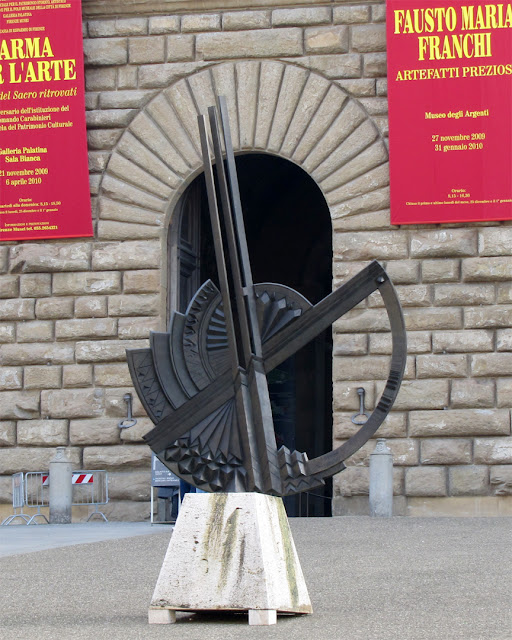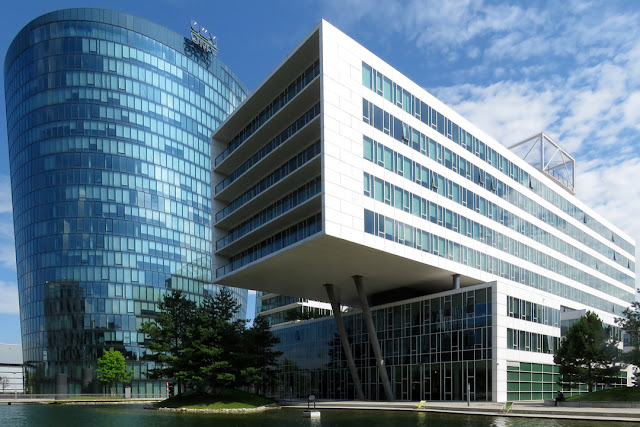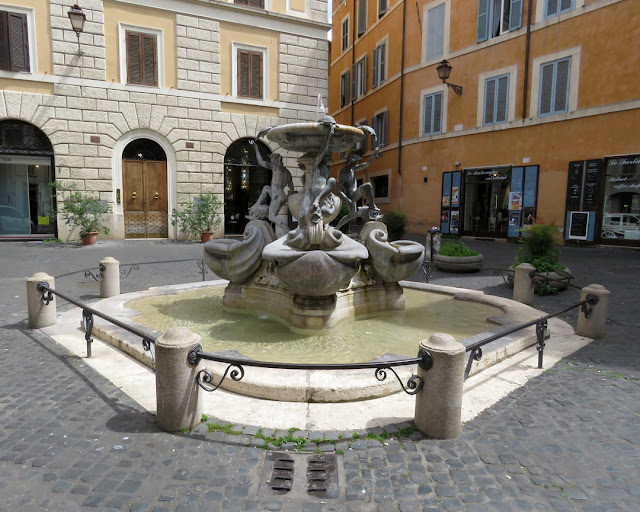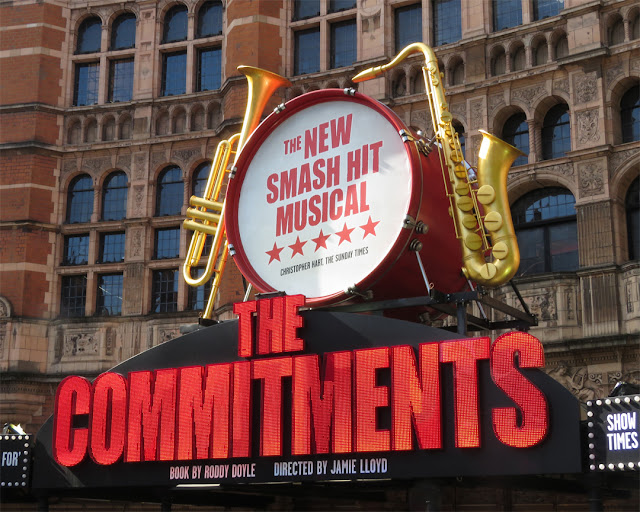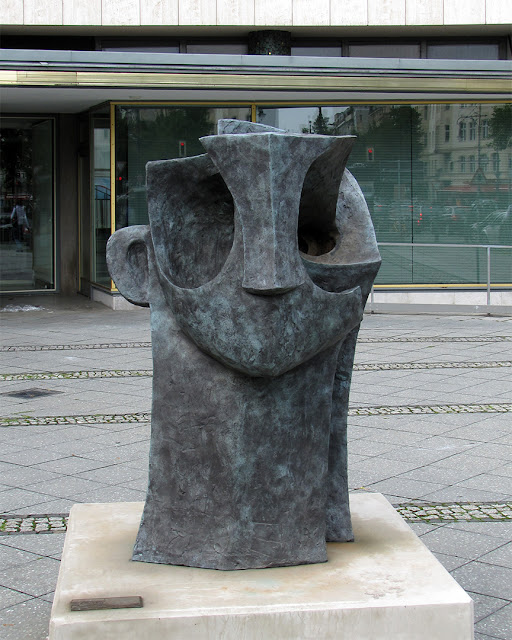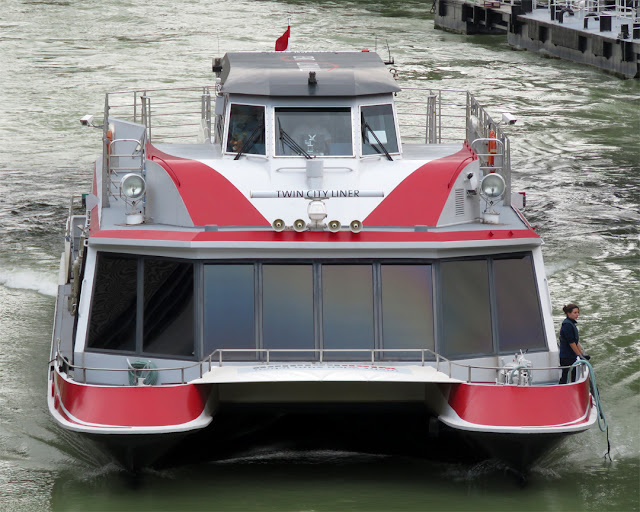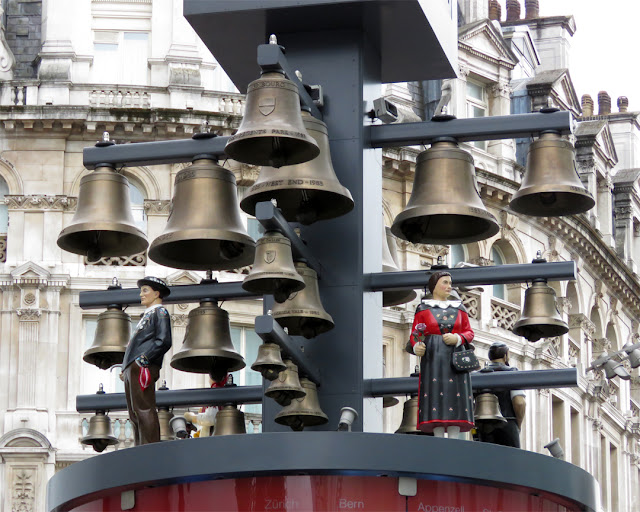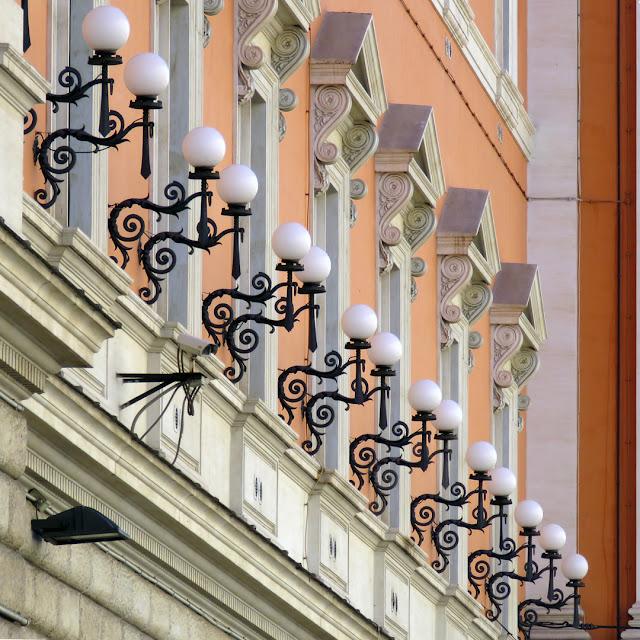Sunday, June 30, 2019
Capital Beach
Capital Beach
Ludwig-Erhard-Ufer, Tiergarten
Berlin, September 2011
“Beach bar in close proximity to the central station and the government district. At the banks of the Spree river, bedded in deck chairs, you can peer at the passing tourist boats and enjoy a cool cocktail.” (Capital Beach, VisitBerlin)
Saturday, June 29, 2019
Via dei Brunelleschi
Detail of the facade
Palazzo Pola e Todescan, 1903
Via dei Brunelleschi
Florence, December 2009
“The Palazzo Pola e Todescan is a building in central Florence, Italy. The palazzo was completed in 1903. It is in the Art Nouveau style and was designed by architect Giuseppe Paciarelli. The building was initially built as residence for Counts of Pola. It housed the Florence branch of Pola & Todescan, a store selling clothing made in Britain. As of 2015, it is occupied by a bank.” (Palazzo Pola e Todescan, Wikipedia)
Friday, June 28, 2019
Thursday, June 27, 2019
Thomas Couture
Grave of Thomas Couture (1815-1879)
Cimetière du Père-Lachaise, (Père Lachaise Cemetery)
Quartier du Père-Lachaise, 20th arrondissement
Paris, July 2014
“Thomas Couture (21 December 1815 – 30 March 1879) was a French history painter and teacher. He taught such later luminaries of the art world as Édouard Manet, Henri Fantin-Latour, John La Farge, Pierre Puvis de Chavannes, Karel Javůrek, and J-N Sylvestre. Couture was born at Senlis, Oise, France. When he was 11 his family moved to Paris, where he would study at the industrial arts school (École des Arts et Métiers) and later at the École des Beaux-Arts. He failed the prestigious Prix de Rome competition at the École six times, but he felt the problem was with the École, not himself. Couture finally did win the prize in 1837. In 1840 he began exhibiting historical and genre pictures at the Paris Salon, earning several medals for his works, in particular for his masterpiece, Romans During the Decadence (1847). Shortly after this success, Couture opened an independent atelier meant to challenge the École des Beaux-Arts by turning out the best new history painters. Couture's innovative technique gained much attention, and he received Government and Church commissions for murals during the late 1840s through the 1850s. He never completed the first two commissions, and the third met with mixed criticism. Upset by the unfavorable reception of his murals, in 1860 he left Paris, for a time returning to his hometown of Senlis, where he continued to teach young artists who came to him. In 1867 he thumbed his nose at the academic establishment by publishing a book on his own ideas and working methods called Méthode et entretiens d'atelier (Method and Workshop Interviews). It was also translated to Conversations on Art Methods in 1879, the year he died. Asked by a publisher to write an autobiography, Couture responded: ‘Biography is the exaltation of personality—and personality is the scourge of our time.’ In 1879 he died at Villiers-le-Bel, Val-d'Oise, and was interred in Père Lachaise Cemetery, Paris.” (Thomas Couture, Wikipedia)
Wednesday, June 26, 2019
Villa Aldobrandini
Villa Aldobrandini Park
Via Nazionale / Via Mazzarino
Rome, May 2019
“You might not be able to easily see the entrance to the park but that small elevation comes with the added bonus of great views once you do stumble upon the old gardens. The park can be found between Via Panisperna and Via Nazionale, with the only accessible entrance on a side street- Via Mazzarino. The villa takes its name from Cardinal Pietro Aldobrandini, who received it from his uncle Pope Clement VIII in 1601. The grounds were actually once much larger and stretched all the way to the Quirinale Palace. The villa was cut short and its gardens remodeled when Termini Station was built in the 19th century. The land was given over to make way for Via Nazionale to connect the train station to Piazza Venezia. The garden still retains its original layout but this is one of those sites in Rome where I just want to shake the city government! The park could be so beautiful but it is instead largely abandoned and left to its own scraggly devices. There are plenty of statues (replicas, in fact) without heads. There are also shady areas and lots of benches to take a break. Unfortunately, the once splendid botanical gardens are now fairly unkempt. You will still find pomegranate and other trees if you keep your eyes peeled. But the best part of Villa Aldobrandini is the view.” (Villa Aldobrandini Park, An American in Rome)
Tuesday, June 25, 2019
25 de Abril Bridge
25 de Abril Bridge
Lisbon, April 2019
“The 25 de Abril Bridge is a suspension bridge connecting the city of Lisbon, capital of Portugal, to the municipality of Almada on the left (south) bank of the Tagus river. It was inaugurated on August 6, 1966. It is often compared to the Golden Gate Bridge in San Francisco, US, because they are both suspension bridges of similar color. It was built by the American Bridge Company which constructed the San Francisco–Oakland Bay Bridge, but not the Golden Gate. With a total length of 2,277 metres (7,470 ft), it is the 40th largest suspension bridge in the world. The upper deck carries six car lanes, while the lower deck carries a double track railway electrified at 25 kV AC; the train platform was added in 1999. From 1966–1974, the bridge was named Salazar Bridge (Ponte Salazar) in honor of Portuguese Prime Minister António de Oliveira Salazar, who ordered its construction. After the Carnation Revolution which overthrew the remnants of Salazar's dictatorship, the bridge was renamed for April 25, the date of the revolution. It is also sometimes called the Tagus River Bridge or in Portuguese Ponte sobre o Tejo (bridge over the Tagus).” (25 de Abril Bridge, Wikipedia)
Monday, June 24, 2019
Sunday, June 23, 2019
L'albero del fuoco
“L'albero del fuoco” (The Tree of Fire) by Giuseppe Calonaci, 1999
Piazza de' Pitti
Florence, December 2009
Saturday, June 22, 2019
Friday, June 21, 2019
Stella-Klein-Löw Weg
Stella-Klein-Löw Weg
Viertel Zwei
Vienna, June 2018
“A 5,000 m² lake forms the centrepiece of Viertel 2, a new urban quarter built in 2011 in Vienna's 5th district, The central zone of the development surrounding the lake is completely car free and there is a sheltered 500 m² children's playground to the rear of the complex. The local infrastructure is superb: the Prater, Krieau trotting track, Messe Wien exhibition centre and University of Economics and Business are just round the corner, with the River Danube and Danube Island also close by. Viertel 2 is just a few minutes from the city centre via the U2 underground station Krieau. The story behind the name: Stella-Klein-Löw-Weg is named after the educational theorist, education policymaker and editor Stella Klein-Löw, who was born in Galicia in 1904.” (Stella-Klein-Löw Weg, Oreg)
Thursday, June 20, 2019
Fontana delle Tartarughe
Fontana delle Tartarughe (Turtle Fountain) by Giacomo della Porta and Taddeo Landini, 1588
Piazza Mattei
Rome, May 2019
“The fountain was designed by the architect Giacomo della Porta (1533–1602) in 1581. He used a design which he repeated in several fountains, which he adapted from earlier ancient Roman fountains. It had a single vasque, or bowl, on a pedestal, from which water spouted upwards and then poured down into polygonal basin. What made the fountain in Piazza Mattei different was the decoration; Mattei commissioned the young sculptor Taddeo Landini, (1550–1596) for his first sculptural commission in Rome, to create statues of four ephebes, or young adolescent men, and eight dolphins. They were originally intended to be of marble but were finally made of bronze, which was more expensive. The Ephebes, in the mannerist style, may have been inspired by eight bronze figures made in 1563-1565 by Bartolomeo Ammannati for the Fountain of Neptune, or du Biancone, in Florence. The fountain is composed of square basin with a circular vasque of African marble mounted on a pedestal in the center. Around the edge of the vasque are the four heads of putti which spout water into the basin below. There are four marble conch shells surrounding the base of the fountain. The four bronze ephebes are placed around the vasque of fountain, each resting one foot on the head of a bronze dolphin, reaching down to hold the tail of the dolphin, and raising up one hand toward the edge of the vasque. Water pours out of the mouths of the dolphins into the conch shells, then into the basin below.” (Fontana delle Tartarughe, Wikipedia)
Wednesday, June 19, 2019
Rua Cor-de-Rosa
Rua Cor-de-Rosa (Pink Street)
Rua Nova do Carvalho
Cais do Sodre
Lisbon, April 2019
“The street officially is called Rua Nova do Carvalho and lies in the now popular neighborhood Cais do Sodre. This used to be Lisbon’s Red Light District. Lisbon was an important port city, meaning lots of sailors would come into the city to gamble, drink, and to ‘get some’. Rua Nova do Carvalho was the place to be, as there were gambling dens, brothels, and seedy bars named after other port cities. Sailors weren’t the only visitors, it was a meeting point for local criminals, streetwalkers, and prostitutes too. Yeah, we bet you didn’t know this quirky street had such shady beginnings! There are still hints to its history though, as many bars still carry port city names, there is still a lingerie store called Purple Rose and the bar Pensao Amor still has an erotic book shop and a sex shop in the back. So how did the red light district turn pink?! Rua Nova do Carvalho was painted not that long ago actually! The painting started in 2011 and was finished by 2013. Since then, it has become locally known as Rua Cor de Rosa, meaning Pink Street. The project was supposed to make the neighborhood better – gentrification at it’s finest. And it has worked. Brothels closed, new bars opened and the street has replaced the shady nightlife and turned it into something hip.” (Rua Nova do Carvalho History, Once Upon a Journey)
Tuesday, June 18, 2019
Asymmetrische Vase
“Vase mit farbigem Mosaik (Asymmetrische Vase)”
(Vase with colored mosaic - Asymmetrical vase) by Gerhard Schultze-Seehof, 1957
Kurfürstendamm, Charlottenburg
Berlin, September 2011
Monday, June 17, 2019
Zodiac on the Wheel
Wheel on Neptune's chariot with Zodiac signs
Fountain of Neptune by Bartolomeo Ammannati
Piazza della Signoria
Florence, December 2009
“At first glance, the Zodiac signs engraved on Neptune’s chariot follow a traditional pattern starting with Aries and ending with Virgo; however, after closer examination, the depiction of Virgo does not follow a traditional representation of Virgo as Virgin, but instead depicts her as a bride. Additionally, Virgo is presented with a unicorn seated on her lap. The combination of these two unusual elements alludes to biblical symbolism. These two figures are anointing this fountaining as a baptistry and proclaiming the water’s purity. Philosophers such as Andrea Bacci suggest that the Virgo in Ammannati's fountain is representing Christ’s bride and the unicorn represents the Christ child. Due to the well-established association of purity with both Virgo and unicorns, Ammannati’s combination of these two figures creates a clear representation of Christ’s purity. In Greek mythology, the unicorn’s purity was so strong that even by placing the tip of its horn in water, it could purify the most toxic water. In Virgo’s right hand we see a loaf of bread where an ear of corn usually lies, furthering the idea that this fountain is being proclaimed as a baptistry.” (Fountain of Neptune, Wikipedia)
Sunday, June 16, 2019
Saturday, June 15, 2019
Grave of Félix Faure
Grave of Félix Faure (1841-1899)
Cimetière du Père-Lachaise, (Père Lachaise Cemetery)
Quartier du Père-Lachaise, 20th arrondissement
Paris, July 2014
“Félix François Faure (30 January 1841 – 16 February 1899) was President of France from 1895 until his death in 1899. Faure was Parisian-born and after working as a tanner in his younger years he became a member of the National Assembly. He became more prominent in French politics up until unexpectedly becoming president, during which time France's relations with Russia improved. Félix François Faure was born in Paris, the son of the small furniture maker Jean-Marie Faure (1809–1889) and his first wife Rose Cuissard (1819–1852). Having started as a tanner and merchant at Le Havre, he acquired considerable wealth, was elected to the National Assembly on 21 August 1881, and took his seat as a member of the Left, interesting himself chiefly in matters concerning economics, railways and the navy. In November 1882 he became under-secretary for the colonies in Ferry's ministry, and retained the post till 1885. He held the same post in Tirard's ministry in 1888, and in 1893 was made vice-president of the chamber.” (Félix Faure, Wikipedia)
Friday, June 14, 2019
Saints Dominic and Sixtus
Santi Domenico e Sisto
(Saints Dominic and Sixtus)
Largo Angelicum
Rome, May 2019
“The Church of Santi Domenico e Sisto (Saints Dominic and Sixtus) is one of the titular churches in Rome, Italy in the care of the Roman Catholic Order of Preachers, better known as the Dominicans. It is located at no. 1 Largo Angelicum on the Quirinal Hill on the campus of the Pontifical University of St. Thomas Aquinas (Angelicum), of which it is the University Church. The titular church is now vacant with the death of the Cardinal Priest of the Church of Saints Dominic and Sixtus, Georges Cottier, O.P., emeritus Theologian of the Pontifical Household who died in 2016. Cottier studied theology and philosophy at the Angelicumobtaining a baccalaurate in philosophy and completing his licentiate in theology in 1952.” (Santi Domenico e Sisto, Wikipedia)
Thursday, June 13, 2019
Fernando Pessoa
Statue of Fernando Pessoa by António Augusto Lagoa Henriques, 1988
Café A Brasileira (The Brazilian Lady Cafe)
Rua Garrett, Chiado
Lisbon, April 2019
“Fernando António Nogueira Pessoa (13 June 1888 – 30 November 1935), commonly known as Fernando Pessoa, was a Portuguese poet, writer, literary critic, translator, publisher and philosopher, described as one of the most significant literary figures of the 20th century and one of the greatest poets in the Portuguese language. He also wrote in and translated from English and French. Pessoa was a prolific writer, and not only under his own name, for he dreamed up approximately seventy-five others. He did not call them pseudonyms because he felt that did not capture their true independent intellectual life and instead called them heteronyms. These imaginary figures sometimes held unpopular or extreme views.” (Fernando Pessoa, Wikipedia)
Wednesday, June 12, 2019
Das innere Auge
“Das innere Auge” (The inner Eye) by Jacqueline Diffring, 1983
Kurfürstendamm, Berlin-Charlottenburg
Berlin, September 2011
“Jacqueline Diffring (7 February 1920 – 28 September 2020) was a German-British sculptor. She was also the sister of actor Anton Diffring. Diffring was born in Koblenz, Germany in February 1920. She began her artistic studies as a 17-year-old at the Reimann School in Berlin. Two years later, severe discrimination and reprisals by the national socialists made her migrate to the UK. Diffring acquired British citizenship and graduated in fine arts at the Technical College in Cambridge in 1946. At Chelsea School of Art in London she studied sculpture with Willi Soukop and Mac William under Henry Moore. Having completed her education at London University, she worked as a teacher at Wisbech Grammar School. Since the early 1960s Jacqueline Diffring lived and worked in France. In 2007 she launched a non-profit organization: The Jacqueline Diffring Foundation, dedicated to promoting art and culture, awarding a yearly €5000 prize to a young international sculptor. Diffring turned 100 in February 2020 and died in September in Châteauneuf Grasse, France.” (Jacqueline Diffring, Wikipedia)
Tuesday, June 11, 2019
Farmacia del Cinghiale
Farmacia del Cinghiale (Pharmacy of the Wild Boar)
Piazza del Mercato Nuovo
Florence, December 2009
“The pharmacy, whose foundation dates from the first half of the 18th century, owes its name to the fountain with a wild boar, known as the ‘Porcellino’, a bronze statue by the sculptor Pietro Tacca (1612) which stood at its entrance in the past, and is now to be found on the shorter side of the Straw Market Loggia. Still today the pharmacy occupies its original site, on the ground floor of a building once owned by the Silk Merchants Guild, then by the Bankers Guild and lastly by the Ospedale degli Innocenti. The pharmacy's ancient origin is documented in an important text, published in Florence in 1752, in which the Florentine physician Niccolò Branchi della Torre listed a series of chemical experiments conducted in the laboratory of this "Spezieria" (the text, now in the Palatino collection of the Biblioteca Nazionale Centrale, bears the significant title ‘Index of chemical experiments that will be demonstrated by Niccola Branchi Doctor in Philosophy and Medicine during the current year MDCCLII in Florence in the Laboratory of the Spezieria del Cinghiale in Mercato Nuovo for the use of some associates’). This text not only testifies to the pharmacy's function as an avant-garde research centre, but it also shows the important status of Branchi, who in 1757 was appointed by Grand Duke Francis Stephen of Lorraine to open the first school of chemistry at Pisa. In the 19th century the pharmacy became a meeting place for illustrious intellectuals, such as the authors Aleardi, Prati, De Amicis and Fucini, the latter recalled by a memorial stone inside the pharmacy. The pharmacy has undergone numerous changes, also subsequent to damage caused by the flood of the Arno in 1966. Of its antique furnishings and original pharmaceutical equipment there remain only a scale for weighing persons and, on the outside, the white and green tiles framing the windows and front door.” (Farmacia del Cinghiale, Museo Galileo)
Monday, June 10, 2019
Ed's Easy Diner
Ed's Easy Diner
Moor Street, Soho
London, September 2015
“Ed's Easy Diner is a casual restaurant chain based in the United Kingdom selling 1950s American diner style items. The first Ed's Easy Diner was opened by Barry Margolis in London's Soho in 1987. In 2008, there were just three diners, all situated in London. As of April 2014, Ed's Easy Diner had 24 outlets, and by September 2016 they had 59. In October 2016, the struggling company experienced poor sales and over-expansion, and was purchased by Boparan Restaurant Holdings after it collapsed into administration. It has now legally a trading division of Boparan's Giraffe Restaurants. After that deal closed, twenty six diners close immediately, and almost four hundred jobs were lost; thirty-three diners remained open, supporting seven hundred jobs. As of January 2019, the company held twenty four diners within the United Kingdom and their first branch in Soho closed its doors for the last time. Six more Ed's Diner locations were set to close in March 2019, due to reduced sales in the casual dining market.” (Ed's Easy Diner, Wikipedia)
Sunday, June 9, 2019
Twin City Liner
Twin City Liner
Schiffstation Wien City
Franz-Josefs-Kai
Vienna, June 2018
“The catamaran Twin City Liner has been a link on the Danube river between the two capitals, Vienna, Austria and Bratislava, Slovakia since 1 June 2006. The path between the two European capitals takes approximately 75 minutes. The first catamaran was built in Norway between the autumn of 2005 and the spring of 2006. The routing was across Skagerrak, on the Northern Sea after the channel Rhine-Main-Danube to Vienna. For this and due to the weight, the shipyard of Norwegian Båtservice Mandal developed a high speed catamaran in aluminium with a hydrojet which can also be used in summer at low tide. The sinking depth in water guaranteed by the contract is 80 cm. To minimize the impact of the waves, complex model tests of the Austrian Institute for Maritime Technology (Schiffbautechnische Versuchsanstalta) took place. The catamaran is totally climate-controlled, and can accommodate 106 passengers and crew (a captain, two sailors and catering staff). During a press conference on August 20, 2007, the Deputy Mayor for Economic Affairs and Finance Vienna Renate Brauner discussed the acquisition of the second Twin City Liner. This second ‘Twinni,’ as nicknamed by the media, was also built by Båtservice Mandal and made the same journey. Besides minor changes to the technical equipment and form, the new Twin City Liner can accommodate up to 126 passengers: 106 seats forward in the passenger cabin, eight seats in the ‘VIP’ cabin on the upper deck and twelve outdoor seats for travel during the summer. The commercial operation of the second Twin City Liner began 31 August 2008.” (Twin City Liner, Wikipedia)
Saturday, June 8, 2019
Head of John the Baptist
Head of John the Baptist by Igor Mitoraj, 2006
Santa Maria degli Angeli e dei Martiri (St. Mary of the Angels and the Martyrs)
Piazza della Repubblica
Rome, May 2019
“Mitoraj was born on 26 March 1944 in Oederan, Germany. His Polish mother was a forced labourer, while his father was a French officer of Polish extraction. He returned with his mother to Poland after the end of World War II. He spent his childhood years in Grojec. He graduated from an art school in Bielsko-Biała and in 1963 he studied painting at the Kraków Academy of Art under Tadeusz Kantor. After graduating, he had several joint exhibitions, and held his first solo exhibition in 1967 at the Krzysztofory Gallery in Poland. In 1968, he moved to Paris to continue his studies at the National School of Art. Shortly afterwards, he became fascinated by Latin American art and culture, spending a year painting and travelling around Mexico. The experience led him to take up sculpture. He returned to Paris in 1974 and two years later he held another major solo exhibition at the Gallery La Hune, including some sculptural work. The success of the show persuaded him that he was first and foremost a sculptor. Having previously worked with terracotta and bronze, a trip to Carrara, Italy, in 1979 turned him to using marble as his primary medium and in 1983 he set up a studio in Pietrasanta. In 2006, he created the new bronze doors and a statue of John the Baptist for the basilica of Santa Maria degli Angeli in Rome.” (Igor Mitoraj, Wikipedia)
Friday, June 7, 2019
Parque Eduardo VII
Parque Eduardo VII
(Eduardo VII Park)
Lisbon, April 2019
“Eduardo VII Park (Parque Eduardo VII) is a public park in Lisbon, Portugal. The park occupies an area of 26 hectares (64 acres) to the north of Avenida da Liberdade and Marquis of Pombal Square in Lisbon's city center. The park is named for King Edward VII of the United Kingdom, who visited Portugal in 1903 to strengthen relations between the two countries and reaffirm the Anglo-Portuguese Alliance. Until Edward's visit the park was called Parque da Liberdade (Liberty Park). In 1945 Portuguese Modernist architect Francisco Keil do Amaral redesigned the park to its current configuration. The Carlos Lopes Pavilion, the former Portuguese pavilion at the 1922 Rio de Janeiro International Exposition, and the Estufa Fria — a 1.5-hectare (3.7-acre) greenhouse garden — are situated within the park. The largest Portuguese flag in the world is usually flown at the park's northern end. The Lisbon Book Fair is held annually in Eduardo VII Park.” (Eduardo VII Park, Wikipedia)
Thursday, June 6, 2019
Würfelskulptur
Würfelskulptur (Cube sculpture) by Sol LeWit, 1993
Hallesches Ufer
Berlin, September 2011
“olomon ‘Sol’ LeWitt (September 9, 1928 – April 8, 2007) was an American artist linked to various movements, including conceptual art and minimalism. LeWitt came to fame in the late 1960s with his wall drawings and "structures" (a term he preferred instead of ‘sculptures’) but was prolific in a wide range of media including drawing, printmaking, photography, painting, installation, and artist's books. He has been the subject of hundreds of solo exhibitions in museums and galleries around the world since 1965. The first biography of the artist, Sol LeWitt: A Life of Ideas, by Lary Bloom, was published by Wesleyan University Press in the spring of 2019.” (Sol LeWitt, Wikipedia)
Wednesday, June 5, 2019
Agostino Bausa
Coat of arms of cardinal Agostino Bausa
Archiepiscopal Palace
Piazza San Giovanni
Florence, December 2009
“Agostino Bausa, OP (23 February 1821 – 14 April 1899) was an Italian cardinal of the Roman Catholic Church. A member of the Dominican Order, he served as Archbishop of Florence from 1889 to 1899. Bausa was born in Florence, Grand Duchy of Tuscany in present Italy, on 23 February 1821. He entered the Order of Preachers, better known as the Dominican Order, and was ordained on 24 March 1845 by Paolo Augusto Foscolo, Latin Patriarch of Jerusalem. Bausa was raised to the rank of cardinal by Pope Leo XIII on 23 May 1887, at the age of 66. Three days later, he was assigned as a Cardinal Deacon the deaconry of Santa Maria in Domnica. On 17 January 1882, Bausa was appointed Master of the Sacred Palace. He served in that position until 23 May 1887. On 11 February 1889, Bausa was appointed Archbishop of Florence and raised to the order of Cardinal Priests with the title of Santa Sabina. On 24 March 1889, he was consecrated as bishop by Pope Leo XIII, with co-consecrators Archbishop Francesco di Paola Cassetta and Bishop Guglielmo Giosafat Giuseppe Pifferi, OSA. He was a strong opponent of blasphemy and desecration of religious holidays, and strong loyalty to Mary and the Eucharist. He frequently spoke for these causes when visiting parishes and their pastors, as well as by his preaching and his numerous writings. He died on 15 April 1899 at the age of 78. Bausa's coat of arms adorns a corner of the Archiepiscopal Palace of Florence.” (Agostino Bausa, Wikipedia)
Tuesday, June 4, 2019
Swiss glockenspiel
Swiss glockenspiel
Coventry Street, West End
London, September 2015
“Two totem columns one displaying the Helvetic cantons insigna, and the other a large carillon clock composed of 23 bells, were preserved in the western section of the square that was finally renamed Swiss Court, in order to retain the Swiss heritage. The glockenspiel, redesigned and restored by the clockmakers Smith of Derby was returned in November 2011, three years after the building demolition.” (Swiss Centre, Wikipedia)
Monday, June 3, 2019
Arsène Houssaye
Grave of Arsène Houssaye (1815-1896)
Cimetière du Père-Lachaise, (Père Lachaise Cemetery)
Quartier du Père-Lachaise, 20th arrondissement
Paris, July 2014
“Houssaye was born in Bruyères (Aisne), near Laon; his original surname was Housset. In 1832 he found his way to Paris, and in 1836 he published two novels, La Couronne de bluets and La Pécheresse. He had many friends in Paris, among them Jules Janin and Théophile Gautier, and he wrote in collaboration with Jules Sandeau. He produced art criticism in L'Histoire de la peinture flamande et hollandaise (1846); semi-historical sketches in Mlle de la Vallière et Mme de Montespan (1860) and Galerie de portraits du XVIII siècle (1844); literary criticism in Le Roi Voltaire (1858) and his famous satirical Histoire du quarante et unième fauteuil de l'Académie française, dealing with notables who failed of election to the French Academy (1855); drama in his Comédiennes (1857); poetry in his Symphonie de vingt ans (1867), Cent et un sonnets (1873), etc.; and novels, Les Filles d'Eve (1852) and many others. He was long editor of L'Artiste and for some years was editor and proprietor of La Presse. In 1849, through the influence of the actress (Eliza) Rachel, he was entrusted with the administration of the Theâtre Français, a position he filled with unfailing tact and success until 1859, when he was made inspector general of fine art. In 1863, when excavating the site of the chapel of Saint-Florentin at the Chateau d'Amboise in the Loire Valley, he found a partially-complete skeleton and stone fragments bearing the inscription 'EO [...] DUS VINC'. The unusually large skull led Houssaye to conclude he had located the remains of Leonardo, which were re-interred in the chapel of Saint-Hubert at the same chateau. Reflecting doubts about the attribution, a plaque above the tomb states that the remains are only "presumed" to be those of Leonardo. In 2016, it was announced that DNA tests were to be conducted to investigate the veracity of the attribution, with results expected in 2019. His Confessions, souvenirs d'un demi-siècle appeared in 1885–91. See also J. Lemaître, Arsène Houssaye (1897), with a bibliography. He died in Paris. His son Henry was a noted historian.” (Arsène Houssaye, Wikipedia)
Sunday, June 2, 2019
Palazzo Baracchini
Ministero della Difesa (Ministry of Defence)
Palazzo Baracchini
Via XX Settembre
Rome, May 2019
“The Ministry of Defence (Italian: Ministero della Difesa, or MDD) is the government body of the Italian Republic responsible for military and civil defence matters and managing the Italian Armed Forces.” (Ministry of Defence, Wikipedia)
Saturday, June 1, 2019
Subscribe to:
Posts (Atom)








